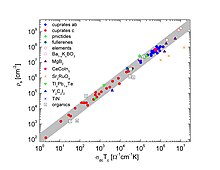Homes's law: Difference between revisions
No edit summary |
Added figure and short discussion on organic superconductors. |
||
| Line 1: | Line 1: | ||
[[File: |
[[File:Universal scaling line.JPG|thumbnail|A log-log plot of the superfluid density versus the product of the |
||
dc conductivity and the critical temperature for: cuprates (a-b plane and c axis), pnictides, |
dc conductivity and the critical temperature for: cuprates (''a-b'' plane and ''c'' axis), pnictides, |
||
elements, TiN, Ba<sub>1-x</sub>K<sub>x</sub>BiO<sub>3</sub>, MgB<sub>2</sub>, organic SC, fullerenes, |
elements, TiN, Ba<sub>1-x</sub>K<sub>x</sub>BiO<sub>3</sub>, MgB<sub>2</sub>, organic SC, fullerenes, |
||
heavy fermion CeCoIn<sub>5</sub>, negative-U induced SC Tl<sub>x</sub>Pb<sub>1-x</sub>Te and |
heavy fermion CeCoIn<sub>5</sub>, negative-U induced SC Tl<sub>x</sub>Pb<sub>1-x</sub>Te and |
||
Y<sub>2</sub>C<sub>2</sub>I<sub>2</sub>. The grey stripe corresponds to ρ |
Y<sub>2</sub>C<sub>2</sub>I<sub>2</sub>. The grey stripe corresponds to ρ<sub>s0</sub> = |
||
(110 ± 60) |
(110 ± 60) σ<sub>dc</sub> T<sub>c</sub>: the units are the same as those in the original |
||
Nature paper.]] |
Nature paper.]] |
||
| Line 37: | Line 37: | ||
S. V. Dordevic, D. N. Basov and C. C. Homes| title = Do organic and other exotic superconductors fail universal |
S. V. Dordevic, D. N. Basov and C. C. Homes| title = Do organic and other exotic superconductors fail universal |
||
scaling relations?| journal = Sci. Rep.|volume = 3| pages = 1713| year = 2012| url = http://dx.doi.org/10.1038/srep01713| |
scaling relations?| journal = Sci. Rep.|volume = 3| pages = 1713| year = 2012| url = http://dx.doi.org/10.1038/srep01713| |
||
doi = 10.1038/srep01713}}</ref> that if the dc conductivity and the superfluid density are measured on the same sample |
doi = 10.1038/srep01713| arxiv = 1305.0019}}</ref> that if the dc conductivity and the superfluid density are measured on the same sample |
||
at the same time using either infrared or microwave impedance spectroscopy, then the organic superconductors do indeed |
at the same time using either infrared or microwave impedance spectroscopy, then the organic superconductors do indeed |
||
fall on the universal scaling line, along with a number of other exotic superconductors. |
fall on the universal scaling line, along with a number of other exotic superconductors. |
||
Revision as of 16:54, 13 December 2013

In superconductivity, Homes's law is an empirical relation that states that a superconductor's
critical temperature (Tc) is proportional to the strength of the superconducting state for temperatures well below Tc close to zero temperature (also referred to as the fully formed superfluid density, ) multiplied by the electrical resistivity measured just above the critical temperature. In cuprate high-temperature superconductors the relation follows the form
,
or alternatively
.
Many novel superconductors are anisotropic, so the resistivity and the superfluid density are tensor quantities; the superscript denotes the crystallographic direction along which these quantities are measured. Note that this expression assumes that the conductivity and temperature have both been recast in units of cm−1 (or s−1), and that the superfluid density has units of cm−2 (or s−2); the constant is dimensionless. The expected form for a BCS dirty-limit superconductor has slightly larger numerical constant of ~8.1.
The law is named for physicist Christopher Homes and was first presented in the July 29, 2004 edition of Nature,[1] and was the subject of a News and Views article by Jan Zaanen in the same issue[2] in which he speculated that the high transition temperatures observed in the cuprate superconductors are because the metallic states in these materials are as viscous as permitted by the laws of quantum physics. A more detailed version of this scaling relation subsequently appeared in Physical Review B in 2005.[3]
Francis Pratt and Stephen Blundell have argued that Homes's law is violated in the organic superconductors. This work was first presented in Physical Review Letters in March 2005.[4] However, it has been recently demonstrated by Dordevic and coworkers[5] that if the dc conductivity and the superfluid density are measured on the same sample at the same time using either infrared or microwave impedance spectroscopy, then the organic superconductors do indeed fall on the universal scaling line, along with a number of other exotic superconductors.
References
- ^ C. C. Homes; et al. (2004). "A universal scaling relation in high-temperature superconductors". Nature (London). 430 (6999): 539–541. arXiv:cond-mat/0404216. Bibcode:2004Natur.430..539H. doi:10.1038/nature02673.
{{cite journal}}: Explicit use of et al. in:|author=(help) - ^ J. Zaanen (2004). "Superconductivity: Why the temperature is high". Nature (London). 430 (6999): 512–513. Bibcode:2004Natur.430..512Z. doi:10.1038/430512a.
- ^ C. C. Homes, S. V. Dordevic, T. Valla and M. Strongin (2005). "Scaling of the superfluid density in high-temperature superconductors". Phys. Rev. B. 72: 134517. arXiv:cond-mat/0410719. Bibcode:2005PhRvB..72m4517H. doi:10.1103/PhysRevB.72.134517.
{{cite journal}}: CS1 maint: multiple names: authors list (link) - ^ F. L. Pratt and S. J. BLundell (2005). "Universal Scaling Relations in Molecular Superconductors". Phys. Rev. Lett. 94: 097006. arXiv:cond-mat/0411754. doi:10.1103/PhysRevLett.94.097006.
- ^ S. V. Dordevic, D. N. Basov and C. C. Homes (2012). "Do organic and other exotic superconductors fail universal scaling relations?". Sci. Rep. 3: 1713. arXiv:1305.0019. doi:10.1038/srep01713.
{{cite journal}}: line feed character in|title=at position 60 (help)





